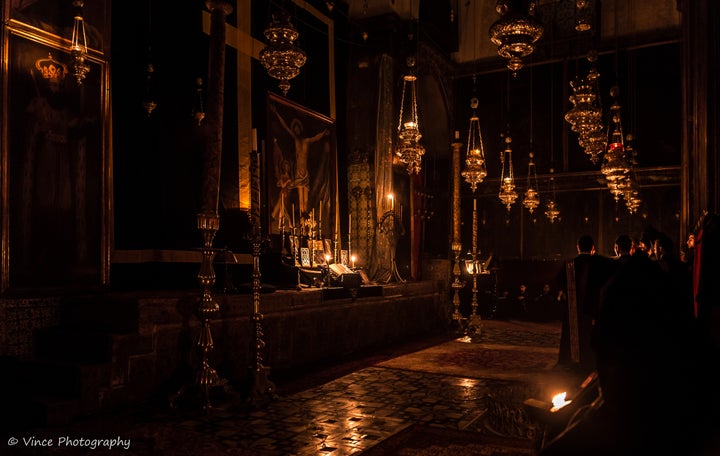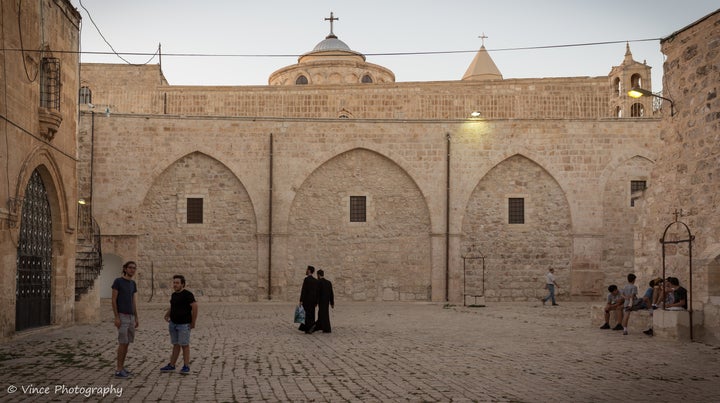Historical Context
As you walk through the alleys of the Old City, you most definitely would stumble upon the Armenian Quarter. Situated on a historic mountain, the Armenian Community of Jerusalem has been living on Mount Zion for several centuries.
In 301, Armenians become the first to adopt Christianity as a state religion. From the beginning of their christianisation, through the mountains of Armenia, the deserts of Syria and Palestine, Armenian pilgrims begin their spiritual journey to Jerusalem, braving political crises and incessant wars of the region. Many of these pilgrims decide to stay, an Armenian Community starts growing at the heart of the city. Through Arab rule, crusades, occupations, the community doesn’t stop flourishing and becomes a great contributor to the shaping of the city. The first printing press (est. 1833), first photography studio (est.1866) are attributed to the Armenian community, and of course its prominent craftsmen (ceramists, jewellers, watchmakers…) add to this avant-garde. The 20th century however, draws a new dreary path.
1948 will radically change the fate of the community. As soon as 1949, 10 000 Armenians leave the country. By the end of the Six day war, the Armenian population is reduced to 3500, and today, after two Intifadas, barely 2000 are left. However, to this day, all the traditions are kept well alive.
This enclave, worthy of Hugo’s descriptions and Constable’s paintings, will leave you in complete awe. Surrounded by the brouhaha of the old city, the chaos of the souk, it is one of the most peaceful places in Jerusalem, if not the Middle East. Its community has the best of both worlds : outstanding middle eastern cuisine and hospitality, and of course Armenian culture and traditions dating back thousands of years. It might be one of the smallest communities of the diaspora, but it is one that has been able to preserve its identity unlike any other.
A day in the Quarter
It’s 5 in the morning, the convent gate opens. The first guest is the waste collector, Jamil or as we call him, Jimmy. He walks around with his carriage, loudly banging doors and hurrying to collect the trash. After all the clatter and the rattle, I can’t help but wake up. I try to sleep again, tossing and turning, to no avail. I decide to get up, make myself a cup of coffee and go on the roof. There I enjoy one of the most beautiful views in the city with the Dome of the Rock shining, and as the clock hits 7, the Saint James’ church bells ringing. The sun starts to rise, my day begins.

It is already 10 and walking through the narrow alleys I can smell fresh coffee beans being roasted. I stop in front of the house of an old lady, Yeghsapet, who has recently fallen ill. I go in and around 6 of her friends are there, talking. To understand the atmosphere you must know that when 6 Armenians gather, there are at least 12 conversations going on. On top of this already noisy ambiance, the tv is on, on the cooking channel fatafeet and 3 among the 12 conversations are about food. I sit next to her, she looks at me and she says : “ This is it. Everyday, they come, drink their coffee, gossip, gossip, while I’m sitting here like an اطرش بالزفه [atrash bil zafe]*.” she laughs. After sticking around for fifteen minutes, I excuse myself and head to the bakery located outside the quarter, in the souk. As I’m leaving the convent through the back gate I hear someone shouting “ Armenian boy, come here”. It’s the guard, the one who calls everyone Armenian boy. He has big thick glasses and looks like a soviet physicist. I go into his spot and he offers me a glass of 100 year old Armenian cognac. Bear in mind it is 11 in the morning and you can never refuse a drink from an Armenian. I take the shot and am on my way.
By noon, I can already start smelling a different spice in every neighbourhood. Some are cooking Dolma ( stuffed zucchini ), others Ma’loube or Mouloukhie… - some kind of Middle Eastern dish. One of the families is preparing Khorovads (barbecue), what you can call the Armenian National dish. The mother is inside spicing the meat, one son is lighting the fire, the father has gone to buy bread and the other son is pouring arak. The neighbour is preparing salads and the bride is setting the table while two toddlers are running around. I get invited and kindly refuse but after much insistency I cannot but accept their offer.
My stomach is full and my head is spinning from all the arak. On the grill, there is a coffee pot and the aroma is travelling through the narrow passageways. Some neighbours join us for coffee and the loud ambiance with endless conversations resumes.
At the peak of the afternoon, 3 o’clock, Saint James’ bells are ringing again. It is time for the daily mass. It takes place in an old 12th century church which hasn’t had any big renovations since the 18th century. No electricity, no microphone, no speakers. Everything is old, it is lit by oil lamps and entering the church is like time-travelling back to the 18th century. Decorated with tiles from Kutahya, a well-know ceramic hub at that time, and paintings from different periods, it offers a unique glimpse into the past. I am sitting quietly on the back benches, listening to our beautiful hymns composed by Gomidas, a 19th century priest, pioneer of Armenian liturgy. With the sound of the thurible going back and forth, back and forth again and again, and the scent of incense burning, I free my mind and open my soul to try and captivate spirituality. Alas, as always, I fail.

The sun is setting and the main courtyard is buzzing with children. Some are riding bikes, others playing outdoor games. The older people are shutting their windows and trying to take a nap while the teenagers are hanging out outside the conservative walls of the Monastery. The middle aged men are playing cards in the clubhouses away from their nagging wives. The main courtyard turns into a melting pot of priests, seniors, parents and children. A recipe for disaster.

Priests and seniors start to complain about the noise and demand that the children go home and sleep. Parents are arguing with them and the children continue playing with their youthful joie de vivre.
The sun sets and it is already 10 P.M. As the gates close, the noise starts to fade and before you know it, it’s 5 am again and Jimmy’s back.
From Shangri-La to Tartarus ?
Our quarter is under direct control of the Armenian Patriarchate of Jerusalem which means that civilians have no say in community issues. There is a synod composed of 30 priests belonging to the Saint James’ brotherhood but the ultimate decision stands with the Patriarch. Authoritarian ? Perhaps, but it is the only way for our lands to be protected. If civilians were to own the properties, all the people who left for political reasons would have sold their houses and left a segregated community, with fewer properties and a greater threat of extinction. However, it is not all black and white. While it is forbidden for individuals to sell properties of the Church, many priests, mainly the ones high up the ladder, have abused their power in the past and sold lands, keeping the money for themselves. Other issues include the confiscation of some properties by the Israeli Authorities, usually due to the presence of weak leadership and a feeble stance by a Patriarch. With an uncertain political situation, reducing demographics and an outdated system, one asks himself : Is the Armenian Community of Jerusalem on the verge of extinction ?
*arabic expression which literally means a deaf person at a wedding; describes someone who doesn't know what's going on around him
For more pictures of the Armenian Community of Jerusalem, visit the page below
